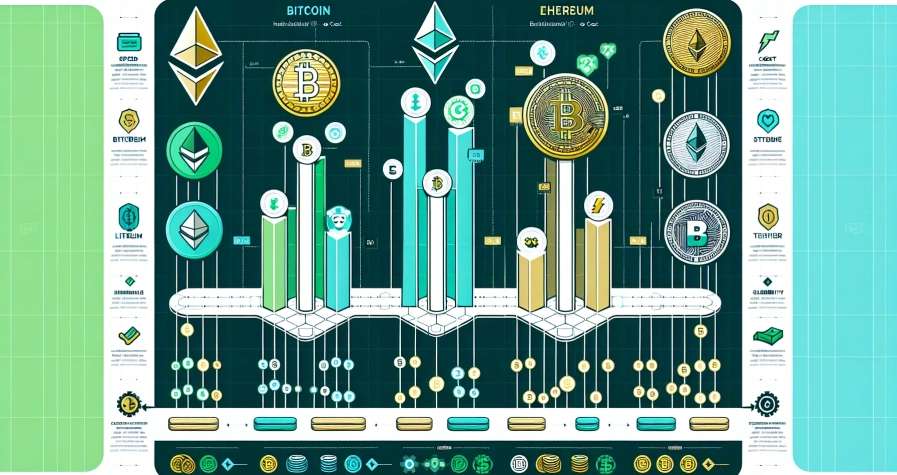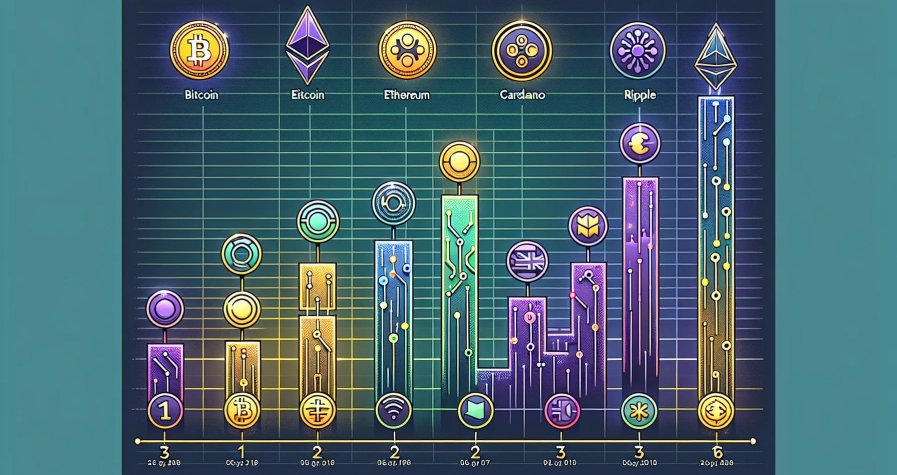Key Takeaways
- Inflation increases crypto token supply through mechanisms like staking rewards and block rewards, potentially diluting individual token value unless demand grows proportionally, whilst deflation decreases supply through token burns and halvings, creating scarcity-driven value appreciation.
- Inflationary cryptocurrencies favour active trading strategies and reward network participation through staking yields of 4-15% annually, making them suitable for DeFi protocols and frequent transactions rather than long-term holding.
- Deflationary tokens serve as portfolio cornerstones for long-term value preservation, with Bitcoin’s fixed 21 million supply cap and Binance Coin’s quarterly burns demonstrating how systematic supply reduction can drive price appreciation over time.
- Hybrid models like Ethereum combine both mechanisms, transitioning from inflationary to partially deflationary through fee burning whilst maintaining block rewards, showing how projects can adapt their monetary policy to balance network security and token value.
- Investment success depends on aligning strategies with tokenomics—choose inflationary tokens for active participation and yield generation, or deflationary assets for store-of-value characteristics and inflation hedging during economic uncertainty.
Understanding inflation and deflation in cryptocurrency markets can dramatically impact your investment decisions and portfolio performance. These economic forces shape token values in ways that differ significantly from traditional currencies yet follow fundamental supply-and-demand principles.
Whilst inflation typically refers to an increase in token supply that can decrease individual token value, deflation occurs when supply contracts through mechanisms like token burns. You’ll find that crypto projects deliberately engineer these dynamics through smart contracts and tokenomics rather than relying on central bank policies.
The distinction becomes crucial when you’re evaluating long-term investment potential. Projects with deflationary mechanisms might preserve or increase value over time, whilst inflationary tokens could see dilution despite growing adoption. Grasping these concepts helps you make informed decisions about which cryptocurrencies align with your financial goals and risk tolerance.
Understanding Inflation and Deflation in Traditional Economics
Understanding traditional economic principles provides the foundation for grasping how inflation and deflation operate within cryptocurrency markets. Central banks control money supply through monetary policy tools such as interest rates, quantitative easing, and reserve requirements to manage price stability across national economies.
Traditional Inflation Mechanisms
Inflation occurs when the general price level of goods and services rises consistently over time, reducing the purchasing power of currency. Central banks typically target annual inflation rates between 2% and 3% to maintain economic stability whilst encouraging growth.
Key inflation indicators include:
- Consumer Price Index (CPI) measuring household goods and services
- Producer Price Index (PPI) tracking wholesale prices
- Core inflation excluding volatile food and energy prices
- Wage inflation reflecting labour market conditions
Traditional Deflation Dynamics
Deflation represents a sustained decrease in general price levels, increasing the purchasing power of money whilst potentially creating economic stagnation. Historical examples such as Japan’s lost decade (1990s-2000s) demonstrate deflation’s impact on consumer behaviour and investment decisions.
Deflation characteristics encompass:
- Decreased consumer spending due to falling price expectations
- Reduced business investment from declining profit margins
- Increased debt burdens as money becomes more valuable
- Potential deflationary spirals creating economic contraction
Monetary Policy Tools and Supply Control
Central banks employ various mechanisms to influence money supply and control inflationary or deflationary pressures. The Federal Reserve, European Central Bank, and Bank of England adjust policy rates to influence borrowing costs and economic activity.
| Policy Tool | Inflationary Effect | Deflationary Effect |
|---|---|---|
| Interest Rate Cuts | Increases money supply | Stimulates spending |
| Quantitative Easing | Injects liquidity | Prevents deflation |
| Reserve Requirements | Controls lending capacity | Manages credit expansion |
| Forward Guidance | Influences expectations | Shapes market behaviour |
Economic Impact on Currency Value
Currency strength correlates inversely with inflation rates under normal economic conditions. High inflation typically weakens currency purchasing power whilst moderate inflation supports economic growth and investment confidence.
Your understanding of these traditional mechanisms enables better comprehension of cryptocurrency tokenomics and how digital assets implement similar concepts through algorithmic protocols rather than centralised monetary authorities.
What Is Inflation in Cryptocurrency?
Inflation in cryptocurrency occurs when the total supply of tokens increases continuously over time through controlled or adjustable mechanisms. You experience this as new tokens entering circulation regularly, which can reduce individual token scarcity and potentially decrease purchasing power if demand doesn’t keep pace.
Inflationary Tokenomics Mechanisms
Predictable token creation forms the core of inflationary cryptocurrency systems. You’ll find these mechanisms distribute newly minted tokens as rewards for network participants including miners, validators, and stakers who contribute to network security and operations.
Staking reward systems create inflation by generating new tokens for validators who lock their holdings to secure proof-of-stake networks. You receive these rewards proportionally to your staked amount, with networks typically issuing 3-12% annual inflation rates to maintain validator incentives.
Block reward mechanisms mint fresh tokens with each validated block, distributing them to miners or validators. You observe this process in networks where new supply enters circulation every few seconds or minutes, maintaining consistent inflation rates that fund network security.
Development fund allocations use inflationary mechanisms to finance ongoing project improvements. You’ll see protocols automatically mint tokens for treasury reserves, enabling continuous funding for upgrades, partnerships, and ecosystem growth without relying on external investment.
| Mechanism Type | Function | Typical Rate | Distribution Method |
|---|---|---|---|
| Staking rewards | Network security | 3-12% annually | Proportional to stake |
| Block rewards | Transaction validation | Variable | Per block creation |
| Development funds | Project funding | 1-5% annually | Treasury allocation |
| Liquidity incentives | Market making | 10-50% initially | Yield farming programs |
Examples of Inflationary Cryptocurrencies
Ethereum demonstrates inflationary mechanics through its proof-of-stake system, where new ETH tokens reward validators for securing the network. You witness approximately 0.5-1% annual inflation as validators receive freshly minted tokens based on their staked holdings and network participation.
Solana operates with inflationary tokenomics that begin at 8% annually and decrease by 15% each year until reaching 1.5% long-term inflation. You benefit from this system if you stake SOL tokens, earning rewards that offset the dilutive effects of new token issuance.
Cardano maintains controlled inflation through its Ouroboros proof-of-stake protocol, distributing ADA rewards to stake pool operators and delegators. You participate in this system by delegating your tokens to stake pools, receiving approximately 4-6% annual returns from newly created tokens.
Cosmos uses inflationary mechanisms to secure its inter-blockchain communication protocol, targeting 7-20% annual inflation depending on the percentage of ATOM tokens staked. You earn higher rewards when fewer tokens are staked network-wide, as the inflation rate adjusts to maintain optimal security participation levels.
What Is Deflation in Cryptocurrency?
Deflation in cryptocurrency occurs when the total token supply decreases over time through systematic removal mechanisms. This contrasts sharply with inflationary models where token quantities continuously expand.
You encounter deflation when cryptocurrencies implement specific protocols that permanently remove tokens from circulation. Token burning represents the most common method, where developers send tokens to unusable wallet addresses that nobody can access. Protocol halvings reduce mining rewards at predetermined intervals, whilst built-in deflation rates automatically decrease supply according to coded parameters.
The economic impact becomes significant when demand remains steady or increases whilst supply contracts. Your holdings potentially gain value as scarcity rises, encouraging long-term retention rather than frequent trading.
Deflationary Tokenomics Mechanisms
Deflationary tokenomics operate through three primary mechanisms that systematically reduce cryptocurrency supply.
Token burning through transaction fees represents the most widespread approach. Networks like Binance Smart Chain burn BNB tokens during each transaction, permanently removing them from circulation. Ethereum’s EIP-1559 update burns a portion of gas fees, creating deflationary pressure when network activity peaks.
Halving events occur at scheduled intervals to reduce mining rewards by 50%. Bitcoin implements this mechanism approximately every four years, cutting new supply issuance from 6.25 BTC to 3.125 BTC per block. These events create supply shocks that historically correlate with price increases.
Protocol-enforced deflation rates operate automatically through smart contract code. Some cryptocurrencies programme scheduled burns or supply reductions that execute without human intervention. These mechanisms typically reduce supply by 1-5% annually, depending on project specifications.
| Mechanism | Example | Frequency | Typical Rate |
|---|---|---|---|
| Fee Burns | Ethereum gas fees | Per transaction | 0.1-2% annually |
| Halvings | Bitcoin mining rewards | Every 4 years | 50% reduction |
| Scheduled Burns | BNB quarterly burns | Quarterly | 1-3% per event |
Examples of Deflationary Cryptocurrencies
Several major cryptocurrencies demonstrate successful deflationary models through different implementation strategies.
Bitcoin (BTC) employs halving events every 210,000 blocks, reducing mining rewards from the initial 50 BTC to the current 3.125 BTC per block. The fixed maximum supply of 21 million coins ensures eventual deflation as mining rewards approach zero. Historical halvings in 2012, 2016, and 2020 preceded significant price rallies.
Binance Coin (BNB) implements quarterly burning events alongside transaction fee burns. Binance commits to burning tokens worth $100 million or more each quarter until the total supply reduces from 200 million to 100 million tokens. Auto-burn mechanisms on Binance Smart Chain remove BNB proportional to gas fees collected.
Ethereum (ETH) transitioned from inflationary to deflationary post-merge through EIP-1559. Base fees get burned whilst priority tips reward validators, creating net deflation during high network activity. Ethereum burns approximately 2-3 ETH per minute when gas prices exceed 15 gwei.
These projects demonstrate how deflationary mechanisms create scarcity whilst maintaining network security and functionality. Your investment decisions benefit from understanding these tokenomics as they directly influence long-term value propositions.
Key Differences Between Crypto Inflation and Deflation
Crypto inflation and deflation represent opposing monetary approaches that fundamentally shape how cryptocurrencies function and perform in your portfolio. These contrasting mechanisms create distinct investment characteristics that affect your long-term returns and trading strategies.
Impact on Token Supply
Inflationary cryptocurrencies operate with continuously increasing token supplies through mechanisms like staking rewards, block mining incentives, and ecosystem development allocations. Projects such as Ethereum mint new tokens at variable rates depending on network activity, whilst Solana maintains approximately 8% annual inflation through validator rewards. These systems prioritise network growth and participant incentives over token scarcity.
Deflationary cryptocurrencies implement fixed or decreasing supply models through systematic removal mechanisms. Bitcoin caps its total supply at 21 million coins with halving events every four years reducing new issuance by 50%. Binance Coin burns tokens quarterly based on trading volume, permanently removing millions of BNB from circulation. Ethereum’s EIP-1559 burns base fees during network transactions, creating deflationary pressure during high activity periods.
| Supply Characteristic | Inflationary Crypto | Deflationary Crypto |
|---|---|---|
| Supply Dynamic | Continuously increasing | Fixed or decreasing |
| Creation Mechanism | Staking rewards, block rewards | Token burns, halving events |
| Long-term Trajectory | Growing token count | Shrinking token count |
| Supply Predictability | Variable rates possible | Fixed schedules common |
Effects on Token Value and Investor Behaviour
Inflationary tokens typically experience dilution pressure as increasing supply can reduce individual token purchasing power unless demand grows proportionally. Ethereum’s transition to proof-of-stake increased staking participation to over 20% of total supply, demonstrating how inflation mechanisms incentivise network participation. These tokens encourage active usage rather than long-term holding, making them suitable for DeFi protocols and frequent transactions.
Deflationary tokens generate scarcity-driven value appreciation as reducing supply creates upward price pressure during stable or increasing demand periods. Bitcoin’s four-year halving cycles historically correlate with significant price increases, whilst BNB burns have removed over 40 million tokens worth billions of dollars. You’ll find deflationary cryptocurrencies attractive for long-term holding strategies and inflation hedging purposes.
Your investment behaviour changes significantly between these models. Inflationary tokens reward active participation through staking yields ranging from 4-15% annually, encouraging you to engage with network governance and validation processes. Deflationary tokens incentivise holding strategies as scarcity increases over time, making them popular choices for investors seeking store-of-value characteristics similar to digital gold.
How Inflation and Deflation Affect Crypto Investments
Inflation and deflation mechanics directly shape your investment outcomes by influencing token scarcity, liquidity patterns and long-term value appreciation potential. Your investment approach must align with these fundamental tokenomics principles to maximise returns whilst managing associated risks.
Investment Strategies for Inflationary Tokens
Focus on projects with robust utility frameworks that drive demand growth beyond supply inflation rates. Ethereum’s transition to proof-of-stake demonstrates how strong ecosystem adoption can offset inflationary pressure through increased network usage and staking participation.
Utilise inflationary tokens for active trading strategies since these assets incentivise circulation over long-term holding. Solana’s 8% annual inflation rate creates natural selling pressure that favours frequent position adjustments rather than buy-and-hold approaches.
Target tokens with dynamic inflation mechanisms that fund continuous development and network improvements. Cosmos adjusts its inflation rate between 7-20% based on staking participation, ensuring protocol sustainability whilst rewarding active validators and delegators.
Monitor demand catalysts that can outpace inflationary supply increases, such as DeFi integration, institutional adoption or major protocol upgrades. Cardano’s research-driven development creates periodic demand spikes that can temporarily overcome its 4.5% annual inflation rate.
Investment Strategies for Deflationary Tokens
Treat deflationary assets as core portfolio holdings designed for long-term value preservation and appreciation. Bitcoin’s fixed 21 million supply cap makes it suitable for decade-long investment horizons, particularly during periods of fiat currency debasement.
Capitalise on token burn mechanisms that permanently reduce circulating supply over time. Binance Coin’s quarterly burns have removed over 165 million tokens since 2017, creating measurable scarcity that supports price appreciation independent of market cycles.
Use deflationary cryptocurrencies as hedges against traditional inflation and economic uncertainty. Bitcoin’s inverse correlation with monetary expansion makes it effective protection when central banks increase money supply during economic crises.
Consider liquidity constraints when sizing deflationary token positions, as reduced supply can limit exit opportunities during market stress. Ethereum’s EIP-1559 burn mechanism creates deflationary pressure but maintains sufficient liquidity for institutional-scale transactions through its large market capitalisation.
Real-World Case Studies of Crypto Inflation vs Deflation
Bitcoin exemplifies deflationary cryptocurrency mechanics through its fixed maximum supply of 21 million coins and programmed halving events. You witness these halvings every four years when block rewards decrease by 50%, systematically reducing new coin issuance and creating scarcity-driven price pressure. Bitcoin’s deflationary design positions it as digital gold, encouraging long-term holding rather than frequent transactions.
Ethereum demonstrates hybrid tokenomics that evolved from inflationary to partially deflationary mechanisms. Initially, Ethereum maintained an inflationary model through continuous block rewards to miners. However, the implementation of EIP-1559 in August 2021 introduced fee burning, where a portion of transaction fees gets permanently removed from circulation. You observe this creating deflationary pressure during high network activity periods, as more ETH burns than gets issued through block rewards.
Binance Coin showcases quarterly burning mechanisms that systematically reduce total supply from its initial 200 million tokens. Binance commits to burning BNB tokens until the supply reaches 100 million, with each quarterly burn based on trading volume and BNB price. You can track these burns through transparent blockchain records, witnessing how this deflationary pressure has contributed to BNB’s long-term value appreciation.
Solana operates an inflationary model with an initial annual inflation rate of 8%, decreasing by 15% yearly until reaching a terminal rate of 1.5%. You benefit from this inflation through staking rewards that compensate validators and delegators for securing the network. This mechanism encourages active participation whilst gradually reducing inflationary pressure over time.
| Cryptocurrency | Supply Model | Annual Rate | Key Mechanism | Impact on Value |
|---|---|---|---|---|
| Bitcoin | Deflationary | Decreasing via halvings | Fixed 21M cap + halvings | Scarcity premium |
| Ethereum | Hybrid | Variable (net deflationary) | Fee burning + block rewards | Price stability focus |
| Binance Coin | Deflationary | Quarterly burns | Trading volume burns | Supply reduction |
| Solana | Inflationary | 8% declining to 1.5% | Staking rewards | Network participation |
| Cardano | Inflationary | ~4.5% | Treasury + rewards | Ecosystem funding |
Cardano maintains an inflationary structure with approximately 4.5% annual inflation distributed through staking rewards and treasury funding. You participate in this system by delegating ADA to stake pools, earning rewards whilst supporting network decentralisation. The treasury component funds ecosystem development, demonstrating how inflation can drive platform growth.
These case studies reveal distinct approaches to monetary policy in cryptocurrency. Deflationary tokens like Bitcoin and BNB create value through scarcity, appealing to investors seeking store-of-value characteristics. Inflationary tokens like Solana and Cardada prioritise network growth and participant incentives, encouraging active ecosystem engagement rather than passive holding.
Understanding these real-world implementations helps you evaluate cryptocurrency projects based on their monetary mechanics and align your investment strategy with tokens that match your financial objectives and risk tolerance.
Conclusion
Understanding inflation and deflation in cryptocurrency markets gives you a powerful advantage when building your investment portfolio. These fundamental concepts directly influence how tokens perform over time and help you predict which projects align with your financial goals.
Your success in crypto investing depends largely on matching tokenomics models to your investment strategy. Whether you’re seeking active rewards through inflationary tokens or long-term value preservation with deflationary assets you’ll make more informed decisions by evaluating these monetary mechanics.
The cryptocurrency space continues evolving with hybrid models and innovative approaches to supply management. By grasping these principles now you’ll be better positioned to navigate future market developments and capitalise on opportunities that traditional investors might overlook.
Frequently Asked Questions
What is crypto inflation and how does it affect token value?
Crypto inflation occurs when the total supply of tokens increases over time through mechanisms like staking rewards, block rewards, and liquidity incentives. This can reduce individual token value if demand doesn’t keep pace with the increased supply. Unlike traditional inflation controlled by central banks, crypto inflation is managed through smart contracts and predetermined tokenomics protocols.
What is crypto deflation and why is it significant for investors?
Crypto deflation involves systematic reduction of token supply through mechanisms like token burning, halving events, and protocol-enforced supply cuts. This creates scarcity, potentially increasing token value over time. Deflationary cryptocurrencies like Bitcoin appeal to investors seeking store-of-value characteristics and long-term appreciation through reduced supply.
How do inflationary cryptocurrencies benefit network participants?
Inflationary cryptocurrencies incentivise network participation through rewards like staking yields, validator payments, and liquidity mining. Projects such as Ethereum, Solana, and Cardano use inflation to fund network security, development, and ecosystem growth whilst rewarding active participants who contribute to network functionality and governance.
Which investment strategies work best for deflationary tokens?
Deflationary tokens suit long-term holding strategies due to their scarcity-driven value appreciation. Investors should treat them as core portfolio holdings, capitalise on token burn mechanisms, use them as hedges against traditional inflation, and consider liquidity constraints when sizing positions for maximum effectiveness.
What are the key differences between inflationary and deflationary crypto models?
Inflationary models prioritise network growth through continuous token supply increases and participant rewards, encouraging active engagement. Deflationary models create scarcity through fixed or decreasing supplies, appealing to long-term holders. The choice affects investment strategies, with inflationary tokens rewarding participation and deflationary tokens offering value preservation.
How should investors choose between inflationary and deflationary cryptocurrencies?
Investors should align choices with financial goals and risk tolerance. For inflationary tokens, focus on strong utility frameworks and active trading strategies. For deflationary tokens, emphasise long-term holding and value preservation. Consider demand catalysts, tokenomics mechanisms, and whether you prefer active participation rewards or scarcity-driven appreciation.









